Superbly detailed blog Post by Jeff on Amazon EC2 Reserved Instance Marketplace
No more words need to be added....
EC2 Options
I often tell people that cloud computing is equal parts technology and business model. Amazon EC2 is a good example of this; you have three options to choose from:
- You can use On-Demand Instances, where you pay for compute capacity by the hour, with no upfront fees or long-term commitments. On-Demand instances are recommended for situations where you don't know how much (if any) compute capacity you will need at a given time.
- If you know that you will need a certain amount of capacity, you can buy an EC2 Reserved Instance. You make a low, one-time upfront payment, reserve it for a one or three year term, and pay a significantly lower hourly rate. You can choose between Light Utilization, Medium Utilization, and Heavy Utilization Reserved Instances to further align your costs with your usage.
- You can also bid for unused EC2 capacity on the Spot Market with a maximum hourly price you are willing to pay for a particular instance type in the Region and Availability Zone of your choice. When the current Spot Price for the desired instance type is at or below the price you set, your application will run.
Reserved Instance Marketplace
Today we are increasing the flexibility of the EC2 Reserved Instance model even more with the introduction of the Reserved Instance Marketplace. If you have excess capacity, you can list it on the marketplace and sell it to someone who needs additional capacity. If you need additional capacity, you can compare the upfront prices and durations of Reserved Instances on the marketplace to the upfront prices of one and three year Reserved Instances available directly from AWS. The Reserved Instances in the Marketplace are functionally identical to other Reserved Instances and have the then-current hourly rates, they will just have less than a full term and a different upfront price.
Transactions in the Marketplace are always between a buyer and a seller; the Reserved Instance Marketplace hosts the listings and allows buyers and sellers to locate and transact with each other.
You can use this newfound flexibility in a variety of ways. Here are a few ideas:
- Switch Instance Types. If you find that your application has put on a little weight (it happens to the best of us), and you need a larger instance type, sell the old RIs and buy new ones from the Marketplace or from AWS. This also applies to situations where we introduce a new instance type that is a better match for your requirements.
- Buy Reserved Instances on the Marketplace for your medium-term needs. Perhaps you are running a cost-sensitive marketing promotion that will last for 60-90 days. Purchase the Reserved Instances (which we sometimes call RIs), use it until the promotion is over, and then sell it. You'll benefit from RI pricing without the need to own them for the full one or three year term. Keep the RIs as long as they continue to save you money.
- Relocate. Perhaps you started to run your application in one AWS Region, only to find out later that another one would be a better fit for the majority of your customers. Again, sell the old ones and buy new ones.
In short, you get the pricing benefit of Reserved Instances and the flexibility to make changes as your application and your business evolves, grows, or (perish the thought) shrinks.
Dave Tells All
I interviewed Dave Ward of the EC2 Spot Instances team to learn more about this feature and how it will benefit our users. Watch and learn:
The Details
Now that I've whet your appetite, let's take a look at the details. All of the functions described below are supported by the AWS Management Console, the EC2 API (command line) tools, and the EC2 APIs.
After registration, any AWS customer (US or non-US legal entity) can buy and sell Reserved Instances. Sellers will need to have a US bank account, and will need to complete an online tax interview before they reach 200 transactions or $20,000 in sales. You will need to verify your bank account as part of the registration process; this may take up to two weeks depending on your bank.
You will not be able to receive funds until the verification process has succeeded.
Reserved Instances can be listed for sale after you have owned them for at least 30 days, and after we have received and processed your payment for them. The RI's state must be displayed as Active in the Reserved Instance section of the AWS Management Console:
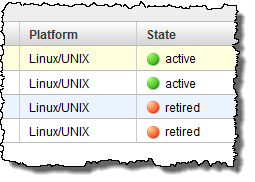
You can list the remainder of your Reserved Instance term, rounded down to the nearest month. If you have 11 months and 13 days remaining on an RI, you can list the 11 months. You can set the upfront payment that you are willing to accept for your RI, and you can also customize the month-over-month price adjustment for the listing. You will continue to own (and to benefit from) the Reserved Instance until it is sold.
As a seller, you will receive a disbursement report if you have activity on a particular day. This report is a digest of all Reserved Instance Marketplace activity associated with your account and will include new Reserved Instance listings, listings that are fully or partially fulfilled, and all sales proceeds, along with details of each transaction.
When your Reserved Instance is sold, funds will be disbursed to your bank account after the payment clears, less a 12% seller fee. You will be informed of the purchaser's city, state, country, and zip code for tax purposes. As a seller, you are responsible for calculating and remitting any applicable transaction taxes such as sales tax or VAT.
As a buyer, you can search and browse the Marketplace for Reserved Instances that best suit your needs with respect to location, instance type, price, and remaining time. Once acquired, you will automatically gain the pricing and capacity assurance benefits of the instance. You can later turn around and resell the instance on the Marketplace if your needs change.
When you purchase a Reserved Instance through the Marketplace, you will be charged for Premium Support on the upfront fee. The upfront fees will also count toward future Reserved Instance purchases using the volume discount tiers, but the discounts do not apply to Marketplace purchases.
Visual Tour for Sellers
Here is a visual tour of the Reserved Instance Marketplace from the seller's viewpoint, starting with the process of registering as a seller and listing an instance for sale. The Sell Reserved Instance button initiates the process:

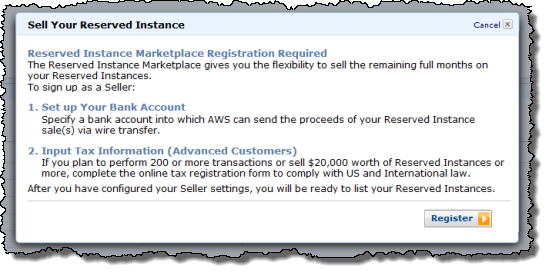
The console outlines the entire selling process for you:
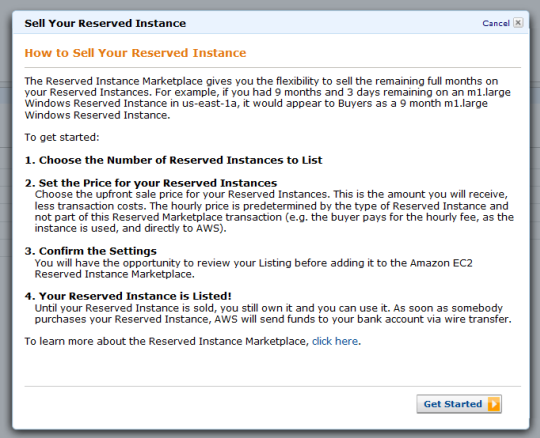
Here's how you set the price for your Reserved Instances. As you can see, you have the ability to set the price on a month-by-month basis to reflect the declining value of the instance over time:
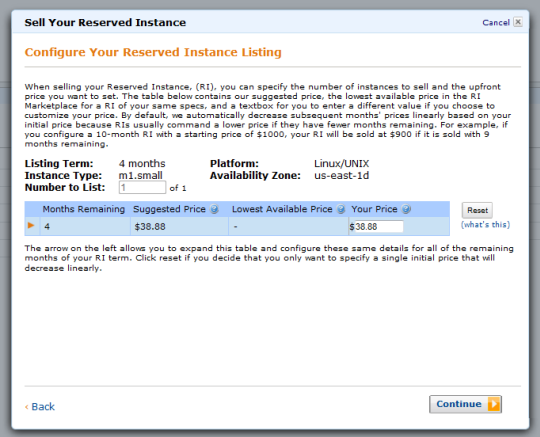
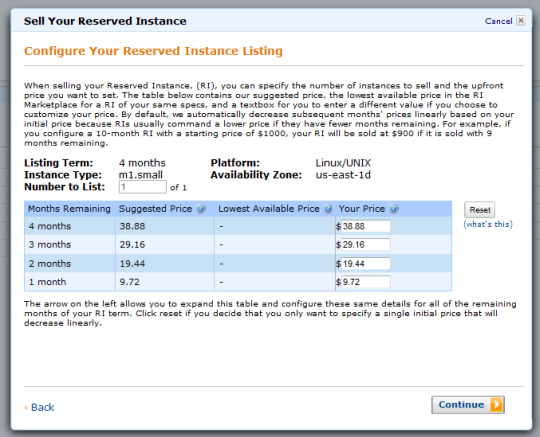
You will have the opportunity to finalize the listing, and it will become active within a few minutes. This is the perfect time to acquire new Reserved Instances to replace those that you have put up for sale:
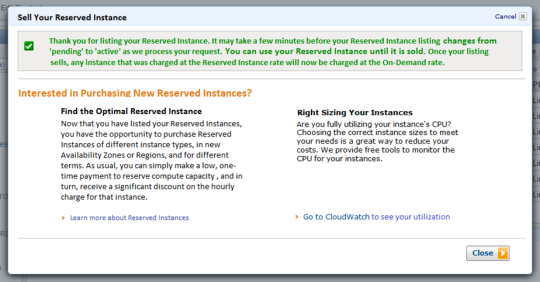
Your listings are visible within the Reserved Instances section of the Console:
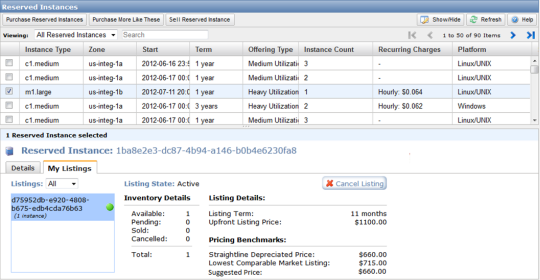
Here's a video tutorial on the selling process:
Visual Tour for Buyers
Here is a similar tour for buyers. You can purchase Reserved Instances in the Console. You start by adding searching for instances with the characteristics that you need, and adding the most attractive ones to your cart:
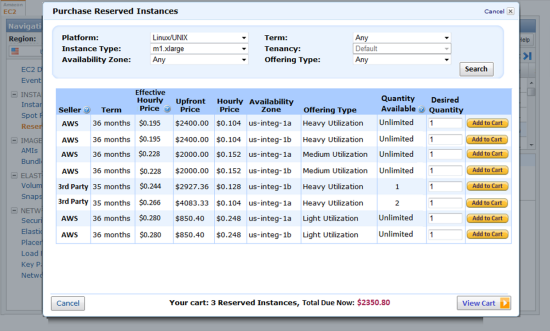
You can then review the contents of your cart and complete your purchase:
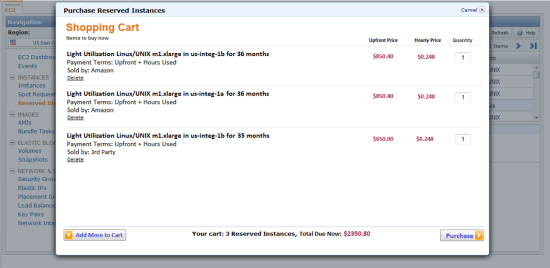
Here's a video tutorial on the buying process:
I hope that you enjoy (and make good use of) the additional business flexibility of the Reserved Instance Marketplace.

It's so nice article thank you for sharing a valuable content. Google cloud online course
ReplyDeleteVery informative blog and useful article thank you for sharing with us , keep posting learn more about aws with cloud computing
ReplyDeleteAWS Online Training
AWS Certification Training